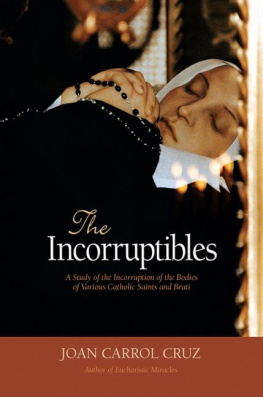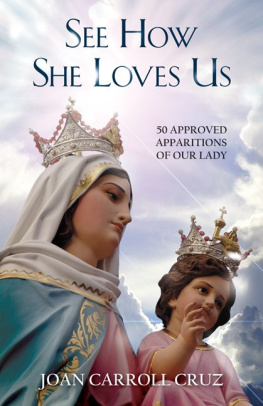Joan Carroll Cruz - Mysteries, Marvels and Miracles: In the Lives of the Saints
Here you can read online Joan Carroll Cruz - Mysteries, Marvels and Miracles: In the Lives of the Saints full text of the book (entire story) in english for free. Download pdf and epub, get meaning, cover and reviews about this ebook. year: 2014, publisher: TAN Books, genre: Religion. Description of the work, (preface) as well as reviews are available. Best literature library LitArk.com created for fans of good reading and offers a wide selection of genres:
Romance novel
Science fiction
Adventure
Detective
Science
History
Home and family
Prose
Art
Politics
Computer
Non-fiction
Religion
Business
Children
Humor
Choose a favorite category and find really read worthwhile books. Enjoy immersion in the world of imagination, feel the emotions of the characters or learn something new for yourself, make an fascinating discovery.

- Book:Mysteries, Marvels and Miracles: In the Lives of the Saints
- Author:
- Publisher:TAN Books
- Genre:
- Year:2014
- Rating:3 / 5
- Favourites:Add to favourites
- Your mark:
- 60
- 1
- 2
- 3
- 4
- 5
Mysteries, Marvels and Miracles: In the Lives of the Saints: summary, description and annotation
We offer to read an annotation, description, summary or preface (depends on what the author of the book "Mysteries, Marvels and Miracles: In the Lives of the Saints" wrote himself). If you haven't found the necessary information about the book — write in the comments, we will try to find it.
Joan Carroll Cruz: author's other books
Who wrote Mysteries, Marvels and Miracles: In the Lives of the Saints? Find out the surname, the name of the author of the book and a list of all author's works by series.
Mysteries, Marvels and Miracles: In the Lives of the Saints — read online for free the complete book (whole text) full work
Below is the text of the book, divided by pages. System saving the place of the last page read, allows you to conveniently read the book "Mysteries, Marvels and Miracles: In the Lives of the Saints" online for free, without having to search again every time where you left off. Put a bookmark, and you can go to the page where you finished reading at any time.
Font size:
Interval:
Bookmark:

HEART TOUCHED BY THE PASSION. The Augustinian mystic, St. Clare of Montefalco, was graced by an apparition of Our Lord in which He said to her, I have sought a place in the world where I might plant My Cross, and have found no better site than your heart. The Saints heart, removed after her death, revealed clearly distinguishable symbols of Our Lords Passion.

OTHER BOOKS BY THE AUTHOR
Miraculous Images of Our Lord
Miraculous Images of Our Lady
Secular Saints
Prayers and Heavenly Promises
The Incorruptibles
Eucharistic Miracles
Relics
Desires of Thy Heart
| Nihil Obstat: | Rev. Stanley P. Klores, S.T.D. Censor Librorum | |
| Imprimatur: |  | Most Rev. Francis B. Schulte Archbishop of New Orleans June 21, 1996 |
The Nihil Obstat and Imprimatur are the Churchs declarations that a work is free from error in matters of faith and morals. It in no way implies that the Church endorses the contents of the work.
Copyright 1997 by Joan Carroll Cruz.
All rights reserved. No part of this book may be reproduced or transmitted in any form or by any means, electronic or mechanical, including photocopying, recording, or by any information storage or retrieval system, without permission in writing from the Publisher, except that brief selections may be quoted or copied for non-profit use without permission, provided that full credit is given.
Cover Picture: The Mystical Marriage of St. Catherine of Siena , by A. Franchi. Used by arrangement with B. N. Marconi, Genoa, Italy.
Library of Congress Catalog Card No.: 96-60581
ISBN: 978-0-89555-541-0
Printed and bound in the United States of America.
TAN Books
Charlotte, North Carolina
www.TANBooks.com
2013
He that believeth in me, the works that I do, he also shall do; and greater than these shall he do.
John 14:12
Since the very beginning of my work I seem to have had a great interest in the wonders related in the lives of the Saints. This interest is revealed in the many marvels mentioned in my first non-fiction book, The Incorruptibles . The subject of phenomena also found its way, in a large part, into my other works: Relics, Eucharistic Miracles, Miraculous Images of Our Lady and Miraculous Images of Our Lord . This present volume, therefore, is a culmination of my interest in this subject of phenomena.
From the outset it should be noted that this is not a textbook study or a detailed analysis of phenomena. An introduction is given for each chapter, followed by interesting examples of the phenomenon. Once again I serve as a reportertelling of many wonders, but leaving all to the judgment and opinion of the reader.
Because of the interesting cases mentioned here, my work has been a pleasure and a most interesting occupation. I pray it will prove to be as interesting to the reader.
It is also my prayer that the reader will derive a greater appreciation of the wonders of God, who has proved by so many miracles His love for His children, His concern for their welfare and His ever-abiding willingness to provide aid in times of distress.
A line from Scripture reads: I will show wonders in the heaven above and signs on the earth beneath. ( Acts 2:19). Through His sainted children, God indeed has worked a great variety of signs and wonders which can be characterized as mysteries, marvels and miracles.
Joan Carroll Cruz
A phenomenon can be defined as something extraordinary; out of the course of nature, a marvel, a wonder; or even as something abnormal. Webster explains it as an instance or deed that is extraordinary in bulk, quantity or degree.
How else can one explain levitation, bilocation, the odor of sanctity and so many other supernatural events mentioned so often in the lives of the Saints?
In introducing this subject we should first look back to Apostolic times following the coming of the Holy Ghost upon the Apostles when St. Paul speaks to the Corinthians of various gifts:
To one, indeed, by the Spirit, is given the word of wisdom: and to another, the word of knowledge, according to the same Spirit; to another, faith in the same spirit; to another, the grace of healing in one Spirit: to another, the working of miracles; to another, prophecy; to another, the discerning of spirits; to another, diverse kinds of tongues; to another, interpretation of speeches. But all these things one and the same Spirit worketh, dividing to every one according as he will. ( 1 Cor . 12: 811).
St. Paul goes on to report his own experience with the phenomenal when he tells:
I know a man in Christ above fourteen years ago (whether in the body, I know not; God knoweth) that he was caught up into paradise, and heard secret words, which it is not granted to man to utter. For such a one I will glory; but for myself I will glory nothing, but in my infirmities. ( 2 Cor . 12:2-5).
One wonders what St. Paul would think if he knew of the many other gifts that would be given in future generations to Gods chosen, such as the stigmata, the ability to subsist on the Holy Eucharist alone, the many events involving mystical hearts, etc.
Who can explain why one soul is given an extraordinary gift and not another? How can it be that many souls who have had a great compassion for Our Lords sufferings have not received the stigmata, while others, who never suspected they would be so graced, received the wounds of the Crucifixion? Certainly, St. Teresa of Jesus did not want to levitate, fought against it at times, but nevertheless levitated in the presence of her sisters and even once in tandem with St. John of the Cross.
But many of the gifts were welcomed, such as those of mystical espousal and marriage, and those gifts that helped the people with whom the Saints came in contact, such as the multiplication of food, the mystical knowledge of a confessor in knowing the sins of a penitent, the quieting of storms, the providing of rain during droughts, or the gift of tongues.
It should be considered that the gift of tongues mentioned in this work is not that described by St. Paul in which one person speaks in an unknown tongue and another interprets the message, but the gift of one of Gods Saints speaking or preaching in his own languagebut understood by those who knew a different language. In other words, no interpreter was needed.
As a by-product of these miracles and phenomena there was a certain awe and respect for the Saint which could only strengthen faith and increase reverence for the One who actually worked the marvel through the instrument of the holy mortal. Of course, the wonders worked by the Saint were also significant in their being introduced to the beatification and canonization processes.
To understand how phenomena were regarded when holy persons were being considered for beatification and canonization, we should briefly consider the canonization process throughout the history of the Church.
Since the earliest days, martyrs for the Faith incurred immediate recognition, their tombs being decorated and piously visited and even the anniversaries of their death being celebrated. This veneration was approved by ecclesiastical authorities who were not blind to the errors and abuses that might occur.
According to Rev. Thomas F. Macken in his work, The Canonisation of Saints , the Church was most prudent in testing the cultus to be paid to martyrs. He gives as an example St. Cyprian (d. 258), who recommended that utmost diligence should be exercised in investigating the claims of those who were said to have died for the Faith. St. Cyprian indicated that the circumstances accompanying the martyrdom were to be investigated; the faith of those who suffered was to be considered, and the motives that animated them were to be rigorously studied. Rev. Macken stated that the utmost caution was employed to prevent the recognition of undeserving personsthis gathered from St. Cyprians letters.
Next pageFont size:
Interval:
Bookmark:
Similar books «Mysteries, Marvels and Miracles: In the Lives of the Saints»
Look at similar books to Mysteries, Marvels and Miracles: In the Lives of the Saints. We have selected literature similar in name and meaning in the hope of providing readers with more options to find new, interesting, not yet read works.
Discussion, reviews of the book Mysteries, Marvels and Miracles: In the Lives of the Saints and just readers' own opinions. Leave your comments, write what you think about the work, its meaning or the main characters. Specify what exactly you liked and what you didn't like, and why you think so.




